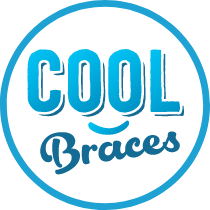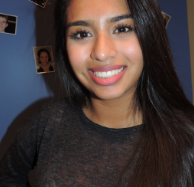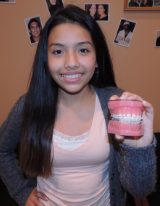Life with Braces

It’s natural to have some questions before you start treatment. We love that you’re curious!
Check out these common questions about life with braces. If you still need answers, let’s chat.
You’ll be relieved to know that getting braces does not hurt. When we place your braces on, we are simply bonding brackets to your teeth, and attaching your archwires to your brackets. This won’t cause you any pain.
The first week you have braces, you may experience some minor soreness as your teeth and gums are adjusting to the support of your braces. You can take some Tylenol® or another over-the-counter pain reliever to counteract the soreness. This should subside after the first week or two.
Yes. We’re proud to offer Same Day Braces, so you can leave your first appointment with braces on your teeth. Once you decide to transform your smile, why wait any longer to get started?
Can you get molds/impressions and braces on the same day? Yes! We can do it all at your complimentary consultation. We’ll examine your teeth, create your personalized treatment plan, create a custom financial plan, then place your braces.
This will depend on a few factors, including your overall oral health, the severity of your case, and your diligence in following directions and wearing your appliances (like rubber bands).
On average, a full treatment can take anywhere from 12 to 36 months, although your case may be shorter or longer.
Once Dr. Tahir completes your free consultation, we’ll have an estimate of how long your treatment period will be. The length of your treatment may change, depending on how quickly your teeth are shifting and whether you wear your appliances as instructed.
Yes, your orthodontic treatment won’t stop you from living your coolest life! As long as you wear a mouthguard when playing sports, you won’t have to sit on the sidelines during the season.
With any type of braces, it’s incredibly important that you wear a mouthguard while playing sports. A mouth guard will protect you and other players from damage.
Don’t worry, you can still eat at your favorite restaurants in Oak Lawn and Berwyn! You’ll be able to eat tons of delicious snacks, meals and desserts with braces too.
During the first week of your treatment, as your teeth and gums are adjusting, you may want to choose softer foods, like pasta, tuna, mashed potatoes, or soup.
Knowing what to eat your first week with braces takes some of your own discretion. You can integrate harder foods into your diet as soon as you’re feeling up to it.
Here’s a list of foods you can eat with braces:
- Dairy — cream cheese, pudding, milk
- Breads — tortillas, pancakes, muffins,
- Grains — pasta, rice, cereal
- Meats — soft chicken, soft meatballs, lunch meats
- Vegetables — cooked carrots, peas, beans
- Fruits — bananas, kiwis, strawberries, grapes
- Treats — ice cream (no nuts), milkshakes, Jell-O, frozen yogurt
As a general rule of thumb, try to avoid foods that are considerably chewy, sticky, crunchy, or hard. These food items are infamous for damaging brackets and wires and breaking orthodontic appliances.
Chewy, sticky foods can stick to your wires and pull them out of place. Hard foods can pop your wires out of place or break a bracket. Next thing you know, you’re visiting us for an emergency orthodontist appointment. As much as we’d love to see you, we want to keep your treatment on track.
Here are some examples of foods to avoid when wearing braces:
- Chewy foods — bagels, hard bread rolls, Twizzlers
- Crunchy foods — popcorn, ice, dried fruits, Cheetos, Doritos, Fritos
- Sticky foods — caramel, gum, Laffy Taffy, Starburst
- Hard foods — nuts, Jolly Ranchers, hard pizza crusts, Nerds
- Foods that require biting — corn on the cob, apples, carrots
As weird as this sensation may be, this is normal! Your teeth and gums are adjusting to your braces. The whole point of your treatment is to shift your teeth into alignment, and with this shifting comes some minor tooth wiggling.
Toward the end of your treatment, once your teeth have shifted into the desired position and you enter the retention phase, your teeth will stabilize and stop wiggling.
If any of your teeth are wiggling considerably and it concerns you, please don’t hesitate to give us a call! We’re here to calm your fears and ensure that you’re working toward the best possible results from your treatment.
Through this assessment, we can determine whether you need orthodontic treatment.
In the meanwhile, here are some signs you can look out for to determine whether you need treatment:
- You have crowding or spacing
- You’re not confident in your smile
- You have difficulty breathing, or you mouth-breathe often
- You have difficulty sleeping
- You feel pain when opening or closing your mouth
- Your jaw pops or clicks when opening your mouth
- Your teeth overlap
- Your top teeth overlap your bottom teeth
- Your bottom teeth overlap your top teeth
- You experience persistent soreness in your teeth or gums
When you get your braces on, our treatment coordinator will show you how to properly brush and floss your teeth!
Maintaining your oral hygiene is especially important during orthodontic treatment. If you don’t brush and floss regularly, bacteria can grow between your teeth and around your brackets and archwires, causing permanent stains, cavities, or gum disease.
Here’s how to properly brush your teeth with braces:
- Brush the outside and inside of your teeth, as well as the chewing surface and gumline.
- Brush in small circles to reach between your archwires and around the corners of your brackets.
- Make sure you’re brushing thoroughly, but gently enough to avoid damaging your braces.
When flossing between your teeth, we recommend using a specialized flossing threader that allows you to insert the floss thread between your teeth and braces. Specialized flossing threaders have a solid end that makes it easier to push the floss through the archwires.
ontent
This will be determined during your free exam. Some patients need rubber bands to align their bite, while others don’t. It all depends on your unique case.
Elastics, or rubber bands, are one of the most common appliances used during treatment with braces. Elastics are hooked around a bracket on the top teeth and a bracket on the bottom teeth to exert persistent (but gentle) force. Over time, this force aligns the teeth and jaw bones and treats malocclusions (poor bite conditions), like overbites, underbites, cross bites, and open bites.
Orthodontic wax is used in the case of minor orthodontic emergencies. If a wire pops loose, or a bracket is irritating your cheeks, orthodontic wax can be applied to the bracket or poking wire to provide temporary relief until you’re able to visit us.
To apply orthodontic wax, you’ll wash your hands, then pinch off a small piece of wax. You’ll roll this piece into a ball, then apply it to the DRY wire or bracket. Squeeze the wax into place to make sure it doesn’t fall off, then run your tongue over the wax to feel for any looseness. If there is too much saliva upon placement, the wax will not stay attached well.
Be sure to give us a call so Dr. Tahir can get your braces fixed at your next appointment.

Ready?
Your smile is a work of art. Let’s make you a magnet for life’s opportunities.
All you have to do is start the convo, and we’ll take it from there.






